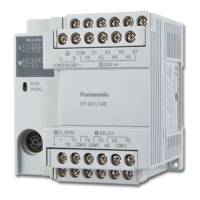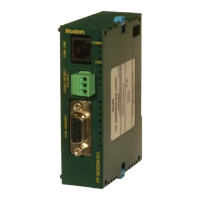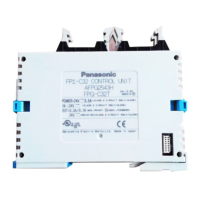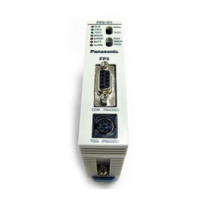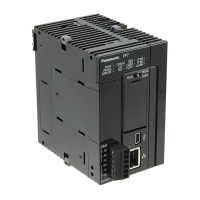(Note 4) The elapsed values are stored in the axis information area of the positioning memory. They can be
read by user programs using the F384 instruction.
■
Control unit (relay output type)
Channel no.
Input / output contact number used Memory area used
CW
or
Pulse
output
CCW
or
Sign
output
Deviati
on
counter
clear
output
Home
input
(Note 1)
Near
home
input
(Note 2)
Over
limit
input
(Note 3)
J-
point
positio
ning
start
input
BUSY
flag
Elapsed value
area
Independent
CH0 Y100 Y101 Y102 X102 (Y70)
(Y80)
(Y81)
X100 X28
(Note 4)
CH1 Y200 Y201 Y202 X202 (Y71)
(Y82)
(Y83)
X200 X29
Linear
interpolation
(Note 1)
Y100
Y200
Y101
Y201
Y102 X102 (Y70)
(Y80)
(Y81)
-
X28
X29
(Note 4)
Y202 X202 (Y71)
(Y82)
(Y83)
(Note 1) Even when setting the linear interpolation, the interpolation operation is not performed for the home
return. Execute the operation for X axes and Y axes separately.
(Note 2) The near home input will be valid when arbitrary inputs are allocated and the output relays indicated in
the above table turn ON.
(Note 3) The over limit input (+) and over limit input (-) will be valid when arbitrary inputs are allocated and the
output relays indicated in the above table turn ON. The I/O numbers in the upper rows (Y80 to Y8A) in
the above table are over limit input (+), the I/O numbers in the lower rows (Y81 to Y8B) are over limit
input (-).
(Note 4) The elapsed values are stored in the axis information area of the positioning memory. They can be
read by user programs using the F384 instruction.
11.2 Allocation of Memory Areas
11-6 WUME-FPXHPOSG-01
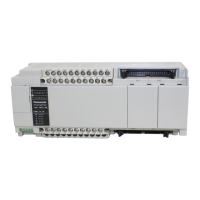
